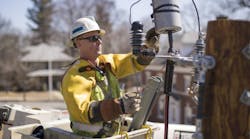The power grid of the future is getting a long-awaited boost. The grid enhancements that have shown a lot of promise, but which have so far been slow to roll out in the U.S. due to a lack of a federal energy policy or even much government backing since the days of the American Recovery and Reinvestment Act of 2009, will receive some federal financial backing in a project that will lend a hand to hundreds of projects.
The funding, part of the Bipartisan Infrastructure Law, is intended to help electric utilities and grid operators install upgrades with potential to fight climate change and extreme weather, while helping deliver reliable and often renewable energy.
The Grid Deployment Office, established in August 2022 to maintain and invest in critical transmission, distribution and generation of power, is allocating $10.5 billion toward the Grid Resilience and Innovation Partnerships (GRIP) projects.
“These programs will accelerate the deployment of transformative projects that will help to ensure the reliability of the power sector’s infrastructure, so all American communities have access to affordable, reliable, clean electricity anytime, anywhere,” according to the Department of Energy website.
There are three different grants that each project falls under. The first are the Grid Resilience Utility and Industry Grants. These receive $2.5 billion over the course of the rollout, amounting to about $600 million per year through 2026. Grants in this category are meant to bolster the electric grid and minimize negative impacts due to extreme weather and natural disasters. Grid operators, electricity storage operators, electricity generators, transmission owners or operators, distribution providers and fuel suppliers may apply for these grants.
The second category, Smart Grid Grants, accounts for about $3 billion of the $10.5 billion. These will amount to $600 million per year through 2026. According to the DOE, these grants will help enhance power system flexibility, efficiency and reliability while paying special attention to boosting the transmission system's capacity, avoiding faults that could spark wildfires, incorporating renewable energy at the transmission and distribution levels, and making it easier to integrate an increasing number of electrified buildings, cars and other grid-edge devices. This grant program is open to institutions such as higher education, non-profits, as well as state, local and Tribal governments.
The largest grant program, which accounts for nearly half of the allocation at $5 billion, is the Grid Innovation Program. This will provide financial assistance to local entities that work with power sector owners and operators to help come up with implementation plans for transmission upgrades, energy storage and distribution infrastructure.
How to Get a GRIP
The DOE’s initial payments for these programs kicked off October 18, with the agency announcing $3.46 billion to help fund 58s total grid projects across all but six states in the US. The utilities involved put up roughly half of the total project amount. The DOE is limiting its funding to the amount that that given entity spent in the last three years on the specific efforts that they are asking help for. Additionally, there is a 100% cost match, with an exception for small utilities that sell no more than 4 million MWh of electricity per year. Those small utilities must match a third of the grant they received.
Maria Robinson, Director of the DOE’s Grid Deployment Office, explained this year’s funded projects in a webinar. Robinson said many utilities wanted to work on projects having to do with wildfire resilience (13 projects), microgrids (11 projects) and renewable integration (17 projects).
Additionally, all projects have Justice40 Initiative commitments, which is a requirement established by an executive order mandating that at least 40% of the benefits of certain federal investments flow towards disadvantaged communities. In addition, 84% of projects include a labor union partnership and make use of some unionized labor at some phase of the construction.
Colin Meehan, a GRIP program project manager, told the webinar audience that project funding came after study of analytics on project effectiveness. Furthermore, Meehan discussed what the next round of applicants should be paying attention to for the second launch of project selection.
“Our intent is to address several different ways that we think we can simplify and expand access to the application process,” said Meehan.
There will be a focus on lowering barriers to entry for the future. The DOE plans to do outreach with project partners to help them meet eligibility and apply.
The agency seeks to make people available to answer questions from applicants, thereby making the application process more efficient and less of a time commitment for project partners. Doing so will include shorter page limits and better feedback. Finally, there will be more overall guidance on the application process such as providing more instructional webinars, technical criteria being simplified, additional guidance identifying priority areas of investment, and requesting interviews for some larger projects to help with selection.
Projects Across the U.S.
The projects themselves run the gamut of geography and technology but are united in their stated aim of delivering more reliable power from a more resilient grid. In hurricane-prone Florida, GRIP funding helped the Florida Municipal Power Agency and Fort Pierce Utilities Authority shore up local storm resilience by upping capacity and upgrading a pair of critical substations at risk of storm surges.
In wildfire-struck Northern California, GRIP money will enable “Project Leapfrog” to get off the ground. Liberty Utilities (CalPeco Electric) will use an array of smart devices, including smart meter reading, network infrastructure and smart meters to achieve better outage management, improved safety and emissions reductions. According to the DOE, Liberty is challenged by the mountainous terrain of its service territory, but this project will develop a smart utility network to deliver better customer service.
In rural North Carolina, Surry-Yadkin Electric Membership Corporation will use a Smart Grid Grant to decrease the impacts of outages by 15% by upgrading some of its outmoded and aging electric infrastructure. The upgraded system will use an automated restoration system with system monitoring capabilities that can identify the cause of outages and minimize their impacts.
In Alleghany and Beaver counties in Pennsylvania, Duquesne Light Co. will deploy grid enhancing technologies to boost their capacity and unlock more clean energy generation. This project will deploy a dynamic line rating application that DLC tested in a pilot project. According to the utility, this more granular data feedback from its distribution grid will enable it to use more distributed energy resources.
Some examples of projects under each grant for the first round of funding are:
Grid Resilience Utility and Industry Projects
Project: New Orleans Line Hardening and Battery Microgrid
Applicant Utility: Entergy New Orleans
Federal Share: $54,828,178
Utility Share: $54,828,178
Goals: Hardening transmission for 97 structures and distribution for 381 structures. Deployment of a battery backup project to lower energy costs for disadvantaged communities in New Orleans. Establish a workforce development program to teach students about clean energy jobs.
Project: Climate Adaptation Resilience Program
Applicant Utility: Hawaiian Electric Company
Federal Share: $95,313,716
Utility Share: $95,313,718
Goals: The goal of Hawaiian Electric's (HE) project is to reduce damage from extreme weather events like hurricanes and wildfires by hardening the electric transmission and distribution system throughout HE's whole service area. Hardening crucial transmission lines, consumer circuits, control centers, and important poles are some of the solutions. Furthermore, the project will undertake work related to lateral undergrounding and attempts to avoid and mitigate wildfires, including the removal of hazardous trees and the improvement of situational awareness.
Smart Grid Projects
Project: Accelerating Building Thermal Electrification While Managing System Impacts
Applicant: Generac Grid Services
Federal Share: $49,835,370
Utility Share: $52,939,597
Goals: “The goal of this initiative is to demonstrate that efficient building electrification can be achieved while minimizing system overloads, reliability issues, and the need for infrastructure upgrades,” according to the DOE’s fact sheet.
Project: Resiliency Enhancement for Fire mitigation and Operational Risk Management
Applicant Utility: PacifiCorp
Federal Share: $49,951,103
Utility Share: $53,186,717
Goals: To develop a comprehensive ecosystem of interoperable technologies to greatly improve situational awareness to prevent or lessen wildfires and to increase the flexibility, dependability, and resilience of the grid.
Grid Innovation Program Projects
Project: Railbelt Innovative Resiliency Project
Applicant Utility: Alaska Energy Authority
Federal Share: $206,500,00
Utility Share: $206,500,000
Goals: “The primary objective of the RIR Project is to address various challenges facing the electrical grid in the three Railbelt regions of Alaska. These challenges include decreasing system frequency regulation, slowing frequency response to disturbances, and increasing natural frequency power oscillations,” according to the DOE’s fact sheet.
Project: Joint Targeted Interconnection Queue Transmission Study Process and Portfolio
Applicant: Minnesota Department of Commerce
Federal Share: $464 million
Utility Share: $1.3 billion
Goals: The project will coordinate five transmission projects spread across seven Midwest states in terms of planning, designing, and building. Many of these obstacles are removed by the JTIQ Portfolio project, which also offers a host of interregional advantages like additional renewable generating, scalable transmission options, reduced energy costs, improved community involvement, and workforce development.
In the near future, there will be more announcements on the current allocation for the first round of funded projects, and that will be consistent through the Fiscal Year 2026. The Biden Administration announced November 14 an additional $3.9 billion to be released for the second round of funding.
This funding, according to the DOE, will focus on projects that develop comprehensive solutions that connect grid communications systems and operations to increase resilience and reduce power outages and threats; deploy cutting-edge technologies like distributed energy resources and battery systems to provide essential grid services; and improve electric transmission by increasing funding and advancing interconnection processes for faster build-out of energy projects.


